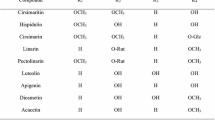Abstract
A flavanol glycoside, glucodistylin (1) and three polyphenol derivatives, gallate (2), (+)-catechin (3) and (+)-gallocatechin (4) were isolated from an aqueous acetone extract of the bark of Quercus acutissima. Of these compounds, glucodistylin exhibited uncompetitive inhibitory activity against recombinant human aldose reductase with an IC50 value of 7.2 μM. Furthermore, glucodistylin inhibited sorbitol accumulation by 48.84% at 50 μM. This flavonoid showed therapeutic potential in the prevention and treatment of diabetes-related complications.
Similar content being viewed by others
Reference
Asano, T., Saito, Y., Kawakami, M., Yamada, N., Sekino, H., and Hasegawa, S., Erythrocytic sorbitol contents in diabetic patients correlate with blood aldose reductase protein contents and plasma glucose levels, and are normalized by the potent aldose reductase inhibitor fidarestat (SNK-860). J. Diabetes Complications, 18, 336–342 (2004).
Crabbe, M. J. and Goode, D., Aldose reductase: a window to the treatment of diabetic complications? Prog. Retin. Eye Res., 17, 313–383 (1998).
Dübeler, A., Voltmer, G., Gora, V., Lunderstädt, J., and Zeeck, A., Phenols from Fagus sylvatica and their role in defence against Cryptococcus fagisuga. Phytochemistry, 45, 51–57 (1997).
Gabbay, K. H., The sorbitol pathway and the complications of diabetes. N. Engl. J. Med., 288, 831–836 (1973).
Haraguchi, H., Ohmi, I., Masuda, H., Tamura, Y., Mizutani, K., Tanaka, O., and Chou, W. H., Inhibition of aldose reductase by dihydroflavonols in Engelhardtia chrysolepis and effects on other enzymes. Experientia, 52, 564–567 (1996).
Haraguchi, H., Ohmi, I., Fukuda, A., Tamura, Y., Mizutani, K., Tanaka, O., and Chou, W. H., Inhibition of aldose reductase and sorbitol accumulation by astilbin and taxifolin dihydroflavonols in Engelhardtia chrysolepis. Biosci. Biotechnol. Biochem., 61, 651–654 (1997).
Hayman, S. and Kinoshita, J. H., Isolation and properties of lens aldose reductase. J. Biol. Chem., 240, 877–882 (1965).
Ishimaru, K., Nonaka, G., and Nishioka, I., Phenolic glucoside gallates from Quercus mongolica and Q. acutissima. Phytochemistry, 26, 1147–1152 (1987).
Kador, P. F., The role of aldose reductase in the development of diabetic complications. Med. Res. Rev., 8, 325–352 (1988).
Kwang-Hyok, S., Ui-Nam, P., Sarkar, C., and Bhadra, R., A sensitive assay of red blood cell sorbitol level by high performance liquid chromatography: potential for diagnostic evaluation of diabetes. Clin. Chim. Acta, 354, 41–47 (2005).
Lee, Y. S., Kang, Y. H., Jung, J. Y., Kang, I. J., Han, S. N., Chung, J. S., Shin, H. K., and Lim, S. S., Inhibitory constituents of aldose reductase in the fruiting body of Phellinus linteus. Biol. Pharm. Bull., 31, 765–768 (2008).
Malone, J. I., Knox, G., Benford, S., and Tedesco, T. A., Red blood cell sorbitol: an indicator of diabetic control. Diabetes, 29, 861–864 (1980).
Malone, J. I., Leavengood, H., Peterson, M. J., O’Brien, M. M., Page, M. G., and Aldinger, C. E., Red blood cell sorbitol as an indicator of polyol pathway activity. Inhibition by sorbinil in insulin-dependent diabetic subjects. Diabetes, 33, 45–49 (1984).
Matsuda, H., Morikawa, T., Toguchida, I., and Yoshikawa, M., Structural requirements of flavonoids and related compounds for aldose reductase inhibitory activity. Chem. Pharm. Bull., 50, 788–795 (2002).
Nishimura, H., Nonaka, G., and Nishioka, I., A gallotannin and two ellagitannins containing a p-hydroxyphenethyl alcohol 1-O-β-D-glucoside (salidroside) core from Quercus stenophylla Makino. Chem. Pharm. Bull., 32, 1735–1740 (1984a).
Nishimura, H., Nonaka, G., and Nishioka, I., Tannins and related compounds. XIX. Eight new gallotannins containing a protoquercitol core from Quercus stenophylla Makino. Chem. Pharm. Bull., 32, 1741–1749 (1984b).
Nonaka, G., Nishimura, H., and Nishioka, I., Seven new phenol glucoside gallates from Quercus stenophylla Makino. Chem. Pharm. Bull., 30, 2061–2067 (1982).
Nonaka, G., Nishimura, H., and Nishioka, I., Isolation and structures of stenophyllanins A, B, and C, novel tannins from Quercus stenophylla Makino. J. Chem. Soc., 33, 163–172 (1985).
Sakushima, A., Ohno, K., Coskun, M., Seki, K.-I., and Ohkura, K., Separation and Identification of Taxifolin 3-O-Glucoside Isomers from Chamaecyparis Obtusa (Cupressaceae). Nat. Prod. Res., 16, 383–387 (2002).
Saraswat, M., Muthenna, P., Suryanarayana, P., Petrash, J. M., and Reddy, G. B., Dietary sources of aldose reductase inhibitors: prospects for alleviating diabetic complications. Asia Pac. J. Clin. Nutr., 17, 558–565 (2008).
Shimizu, M., Terashima, T. I. S., Hayashi, T., Arisawa, M., Morita, N., Kurokawa, S., Ito, K., and Hashimoto, Y., Inhibition of lens aldose reductase by flavonoids. Phytochemistry, 23, 1885–1888 (1984).
Shinohara, R., Ohta, Y., Yamauchi, M., and Ishiguro, I., Improved fluorometric enzymatic sorbitol assay in human blood. Clin. Chim. Acta, 273, 171–184 (1998).
Suzen, S. and Buyukbingol, E., Recent studies of aldose reductase enzyme inhibition for diabetic complications. Curr. Med. Chem., 10, 1329–1352 (2003).
Tanaka, N., Shimomura, K., and Ishimaru, K., Tannin productin in callus cultures of Quercus acutissima. Phytochemistry, 40, 1151–1154 (1995).
Ueda, H., Kawanishi, K., and Moriyasu, M., Effects of ellagic acid and 2-(2,3,6-trihydroxy-4-carboxyphenyl) ellagic acid on sorbitol accumulation in vitro and in vivo. Biol. Pharm. Bull., 27, 1584–1587 (2004).
Vertommen, J., Rillaerts, E., Gysels, M., and De Leeuw, I., Erythrocyte sorbitol content in diabetic patients: relation to metabolic control. Diabete Metab., 13, 182–186 (1987).
Author information
Authors and Affiliations
Corresponding author
Rights and permissions
About this article
Cite this article
Lee, Y.S., Kim, J.K., Bae, Y.S. et al. Inhibitory effect of glucodistylin from the bark of Quercus acutissima on human recombinant aldose reductase and sorbitol accumulation. Arch. Pharm. Res. 34, 211–215 (2011). https://doi.org/10.1007/s12272-011-0205-1
Received:
Accepted:
Published:
Issue Date:
DOI: https://doi.org/10.1007/s12272-011-0205-1




